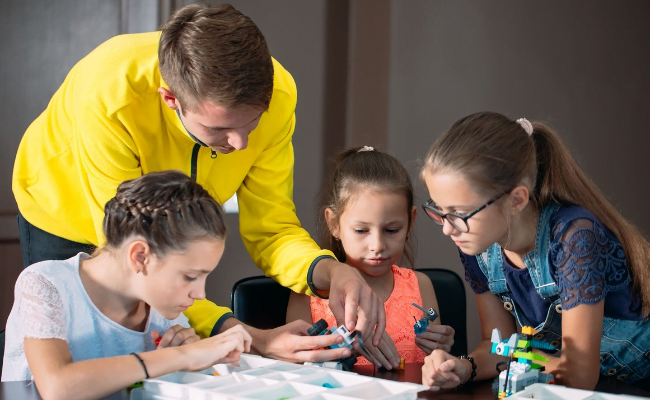Understanding how long a child should have screen time is essential for parents navigating digital media today. Children and screens are inseparable; thus, controlling screen time is crucial for a child’s health and development.
In this guide, you will learn about ideal screen time for various age groups, the effects of excessive screen time, and strategies for setting healthy screen time limits.
What is the Ideal Screen Time for Different Age Groups?
Determining the ideal screen time for children varies significantly based on age. Different age groups have different needs and developmental considerations.
Infants and Toddlers (0-2 Years)
For children younger than 2, it is recommended to have little to no screen time. The American Academy of Pediatrics advises against screen media for this age group.
Infants and toddlers learn best through face-to-face interaction.
Screen use can interfere with sleep.
Aim for tactile and social engagement instead.
Preschoolers (3-5 Years)
Screen time for preschoolers should be limited to one hour per day. This hour should be high-quality programming.
Use educational programming to enhance learning.
Encourage interactive screen time activities.
Ensure screen time isn’t during meals or before bed.
School-age children (6-12 Years)
For school-age children, total daily screen time should not exceed two hours.
Balance screen time with physical activity.
Introduce digital media responsibly.
Focus on household rules to manage time spent on screens.
Teenagers (13-18 Years)
Teenagers’ screen time needs to be monitored closely, even though they might require longer screen use for school-related tasks. Limit non-educational screen time to around two hours daily.
Educate about healthy media use habits.
Encourage real-life social skills development.
Avoid screens one hour before bed to prevent sleep problems.
What Are the Effects of Too Much Screen Time on Children?

Too much screen time can have various negative effects on a child’s health, impacting their physical, mental, and social well-being. It’s essential to understand these impacts to manage a child’s screen time effectively.
Physical Health Impacts
Excessive screen time can lead to physical health problems in children.
Weight Gain: Sedentary behavior from screen use often results in less physical activity, contributing to obesity.
Eye Strain: Prolonged exposure to screens can cause digital eye strain and discomfort.
Sleep Problems: Blue light from screens can interfere with sleep patterns, leading to sleep problems and less sleep overall.
Mental Health Impacts
Extended screen time can affect a child’s mental health in various ways.
Anxiety and Depression: Excessive screen usage, especially on social media, can increase feelings of anxiety and depression.
Attention Issues: Constant screen exposure can reduce a child’s ability to concentrate and may contribute to attention deficit issues.
Behavioral Problems: Studies indicate a correlation between high screen time and behavioral issues such as aggression and irritability.
Social Development Concerns
Spending excessive time with screens can hinder a child’s social development.
Decreased Social Skills: Limited face-to-face interaction can impair the development of crucial social skills.
Family Interaction: Increased screen use often leads to reduced family time, affecting family values and dynamics.
Less Real-Life Engagement: Excessive screen time can substitute valuable in-person interactions with other children and adults.
How to Recognize Symptoms of Too Much Screen Time
Monitoring for symptoms of excessive screen time is crucial for maintaining a child’s health. Identifying these signs early can help parents take corrective action.
Physical Symptoms
Be vigilant for physical signs indicating that a child might be spending too much time on screens.
Eye Discomfort: If a child frequently rubs their eyes or complains of eye strain, it could be due to excessive screen time.
Headaches: Regular headaches might be a symptom of prolonged exposure to screens.
Poor Posture: Watch for signs of bad postures, such as slouching or neck pain, as these are common with extended screen use.
Behavioral Changes
Behavioral changes can also signal excessive screen use.
Irritability and Tantrums: Noticeable mood swings or irritability after screen time can be a sign of overuse.
Lack of Interest: If a child shows reduced interest in other activities they used to enjoy, it may indicate too much screen time.
Sleep Disruption: Changes in sleep patterns, such as difficulty falling asleep or waking frequently, can be linked to too much screen exposure, especially before bedtime.
Monitoring and recognizing these symptoms helps in maintaining a balanced screen time for the child, ensuring their overall well-being.
How to Set Healthy Screen Time Limits

Setting healthy screen time limits is essential for fostering a balanced lifestyle in children. It involves creating rules and using tools to manage screen usage effectively.
Creating Screen-Free Zones
Designating specific areas in the home as screen-free zones helps control a child’s screen time.
Bedroom: Keep screens out of the child’s bedroom to promote better sleep hygiene.
Dining Area: Make meal times a screen-free period to encourage family interaction.
Study Area: Ensure study spaces are free from distractions like TVs and game consoles.
Establishing a Daily Screen Time Schedule
Creating a structured screen schedule encourages responsible media use.
Set Time Limits: Allocate specific times for activities like homework, physical activities, and leisure screen time.
Consistent Routine: Maintain a consistent schedule to establish good media habits.
Reward System: Use incentives to encourage adherence to screen time rules.
Using Parental Control Tools
Parental control tools are effective in managing and monitoring screen usage.
App Restrictions: Use apps to limit access to certain types of media or games.
Time Management: Employ timers and daily limits to control the duration of screen use.
Monitoring Software: Utilize software to track screen time and ensure content is age-appropriate.
Balancing Screen Time with Other Activities
Achieving a balanced lifestyle requires integrating other enriching activities alongside screen time. This promotes overall well-being and development in children.
Promoting Physical Activity
Encouraging physical activity is crucial for a child’s growth and health.
Outdoor Play: Incorporate outdoor activities like biking, hiking, or playing sports.
Exercise Routines: Establish regular exercise routines that the whole family can participate in.
Active Breaks: Include short, active breaks during screen time to reduce sedentary behavior.
Encouraging Creative Play
Creative play stimulates cognitive and social development.
Art and Crafts: Introduce art projects, drawings, and crafts to develop creativity.
Building and Construction Toys: Use Legos, building blocks, or DIY kits to engage in problem-solving and hands-on skills.
Storytelling and Role-Playing: Encourage imaginative play through storytelling sessions and role-playing games.
Family Time Without Screens
Spending quality family time strengthens relationships and reduces reliance on screens.
Board Games: Engage in board games or puzzles that promote interaction and fun.
Reading Together: Set aside time for family reading sessions to cultivate a love for books.
Outdoor Activities: Plan family outings like picnics, park visits, or nature walks to foster togetherness without screens.
Balancing screen time with these activities supports a child’s holistic development, ensuring a healthy and enriching upbringing.
The Role of Playing Video Games in Screen Time
Video games can be both beneficial and detrimental to children, depending on how they’re used. It’s important to manage and understand their impact on a child’s screen time.
Benefits of Educational and Interactive Games
Educational and interactive games can have positive effects on children.
- Cognitive Skills: These games can enhance problem-solving, critical thinking, and strategic planning skills.
- Learning Enhancement: Educational games can reinforce concepts learned in school, such as math or language skills.
- Social Interaction: Multiplayer and cooperative games can improve social interaction and teamwork.
Setting Limits on Video Game Play
Balancing video game play is essential to maintain a healthy media diet.
- Time Limits: Restrict gameplay to a specified duration each day, ensuring it doesn’t exceed screen time guidelines.
- Content Monitoring: Choose age-appropriate and high-quality programming that aligns with family values and educational goals.
- Active Engagement: Encourage breaks and incorporate physical activity during gaming sessions to counteract sedentary behavior.
What to Do When Your Child Exceeds Screen Time Limits?
Managing situations where a child exceeds screen time limits requires tact and practical strategies. These measures ensure compliance and promote healthy screen habits.
Addressing Overuse Tactfully
Handling excess screen time should be done with care to avoid conflict.
- Calm Discussion: Talk to your child calmly about the importance of limiting screen time.
- Understanding Reasons: Ask why they spent more time than allowed and find common ground or solutions.
- Positive Reinforcement: Reward adherence to screen time limits instead of punishing overuse.
Reintroducing Non-Screen Activities
Encouraging alternative activities helps reduce reliance on screens.
- Hobbies and Interests: Promote hobbies such as reading, playing musical instruments, or sports.
- Family Projects: Engage in joint family activities that are screen-free, like cooking or gardening.
- Social Engagement: Arrange playdates or community activities to foster social interactions with other children.
Balancing screen time with engaging in real-world activities ensures a child develops holistically, mitigating the adverse effects of excessive screen use.
Final Thoughts
Navigating the digital landscape and managing a child’s screen time is a shared responsibility between parents, educators, and caregivers. Balanced screen time ensures children reap the benefits of technology while avoiding potential negative impacts.



